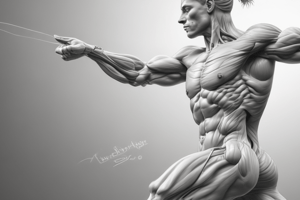Podcast
Questions and Answers
What is the primary function of muscles in the body?
What is the primary function of muscles in the body?
Which layer of connective tissue covers the entire skeletal muscle?
Which layer of connective tissue covers the entire skeletal muscle?
Which type of muscle is characterized by striated appearance and voluntary control?
Which type of muscle is characterized by striated appearance and voluntary control?
What component primarily composes thick filaments in muscle fibers?
What component primarily composes thick filaments in muscle fibers?
Signup and view all the answers
What separates individual muscle fibers within the fascicle?
What separates individual muscle fibers within the fascicle?
Signup and view all the answers
Which of the following is NOT a category of skeletal muscle proteins?
Which of the following is NOT a category of skeletal muscle proteins?
Signup and view all the answers
Fascia serves which primary purpose within the muscular system?
Fascia serves which primary purpose within the muscular system?
Signup and view all the answers
Which protein is primarily involved in the regulatory function of muscle contraction?
Which protein is primarily involved in the regulatory function of muscle contraction?
Signup and view all the answers
What role do desmin and filamin play in muscle structure?
What role do desmin and filamin play in muscle structure?
Signup and view all the answers
Which component becomes active first in the transmission of a nerve impulse to muscle contraction?
Which component becomes active first in the transmission of a nerve impulse to muscle contraction?
Signup and view all the answers
What primarily causes the muscle contractions to occur at the molecular level?
What primarily causes the muscle contractions to occur at the molecular level?
Signup and view all the answers
Which structure acts as a specialized plasma membrane in muscle cells?
Which structure acts as a specialized plasma membrane in muscle cells?
Signup and view all the answers
What is the primary role of troponin and tropomyosin in muscle contraction?
What is the primary role of troponin and tropomyosin in muscle contraction?
Signup and view all the answers
What initiates the sliding filament model of muscle contraction?
What initiates the sliding filament model of muscle contraction?
Signup and view all the answers
Which cellular structure is primarily involved in storing calcium ions for muscle contraction?
Which cellular structure is primarily involved in storing calcium ions for muscle contraction?
Signup and view all the answers
What occurs during the power stroke phase of muscle contraction?
What occurs during the power stroke phase of muscle contraction?
Signup and view all the answers
Study Notes
Muscular System Overview
- Muscles are responsible for all types of body movement
- They contract or shorten, acting as the body's machines
- Three main types: skeletal, cardiac, and smooth muscle
Learning Outcomes
- Describe the microscopic anatomy of skeletal muscle fibers
- Define sarcomere
- Describe muscle proteins
Organization of Skeletal Muscle
- Muscle belly -> Fascicle -> Muscle fiber (muscle cell) -> Myofibrils -> Myofilaments -> Sarcomere
- Myofibrils: Structures within muscle fibers
- Myofilaments: Proteins that make up the sarcomere
- Myosin: Thick filaments
- Actin: Thin filaments
- Sarcomere: The functional unit of a muscle fiber, responsible for striated appearance
Skeletal Muscle Fiber Structure
- Cells are multinucleated (multiple nuclei)
- Nuclei are located just beneath the membrane
- Sarcolemma: Specialized plasma membrane of the muscle cell
- Myofibrils: Bundles of myofilaments within the muscle cell
- Dark band (A-band) and Light band (I-band) visible under microscopy
Muscle Protein Types
- Myofibrillar proteins: Contractile, structural, and regulatory proteins—including myosin and actin
- Sarcoplasmic proteins: Essential for connecting myofibrils to the sarcolemma and maintaining muscle structure (e.g., desmin and filamin)
- Stromal proteins: The primary component of connective tissue in the muscle; includes collagen (important), elastin, laminin, fibronectin, and proteoglycans. Cells like fibroblasts, macrophages, lymphoid, mast, and eosinophils are also present.
Skeletal Muscle Coverings
- Epimysium: Covers the entire muscle
- Perimysium: Surrounds bundles of muscle fibers (fascicles)
- Endomysium: Separates individual muscle fibers
- Fascia: Layer of fibrous tissue separating muscles from each other and the skin
Skeletal Muscle Attachments
- Epimysium blends into a connective tissue attachment (tendon)
- Tendon: Cord-like structure that connects muscle to bone
- Muscle attachments include bones, cartilages, and connective tissue coverings
Physiology of Muscle Contraction
- Skeletal muscles must be stimulated by a motor neuron to contract
- Motor neuron: Nerve cell that transmits signals to muscle cells
- Neurotransmitters are released to stimulate muscle contraction (e.g. acetylcholine)
Sliding Filament Theory
-
Muscle contraction occurs due to the sliding of actin and myosin filaments.
-
Thin actin filaments slide over thick myosin filaments, shortening the sarcomere, and thus the muscle.
-
Requires ATP (energy) and calcium ions.
-
Steps of Muscle Contraction:
- Influx of calcium initiates cross-bridge formation (actin and myosin)
- Myosin heads change shape and pull on the actin filaments, sliding them towards the center of the sarcomere.
- ATP causes myosin heads to detach from actin.
- The cycle is repeated, causing continuous muscle shortening.
Studying That Suits You
Use AI to generate personalized quizzes and flashcards to suit your learning preferences.
Related Documents
Description
Test your knowledge on the functions, proteins, and structures of muscles in the human body. This quiz covers key concepts such as muscle types, connective tissue layers, and molecular mechanisms of muscle contraction. Perfect for students studying anatomy and physiology.




